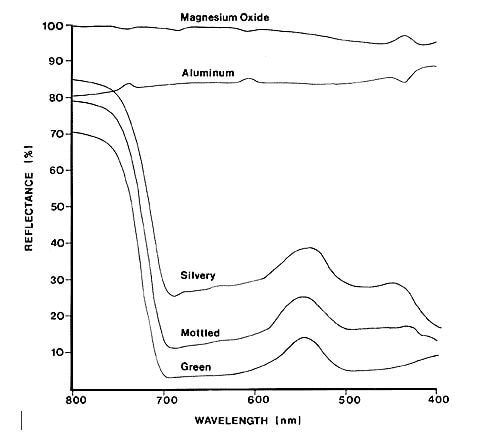Cucurbit Genetics Cooperative Report 6:89-90 (article 45) 1983
O. Shifriss1
Rutgers University, New Brunswick, NJ 08903
The silvery-leaf trait is conditioned by gene M. This gene can bring about a breakdown of intercellular cohesion in the upper tissue of the leaf, leading to air spaces between the palisade cells as well as between the palisade and epidermal layers. The air spaces modify the reflection of light and this in turn results in silvery appearance. Three major factors contribute to variations in the silvery-leaf trait. (i) Cell position. The most vulnerable cells to the action of M are located in axils of leaf veins. (ii) Modifier genes. These profoundly affect the time, intensity, and extent of M expression. (iii) Nongenetic influences which include temperature. Leaves of some M/M lines exhibit a mottled pattern and leaves of other M/M lines manifest a silvery expression that is uniform over their entire surface (2, 3, 4).
Reflected light spectra were obtained from leaves of three distinct lines, using Shimadzu Digital Double-Beam Spectrophotometer (Bausch & Lomb). The three lines were ‘Early Prolific Straightneck’ bearing green leaves, m/m; an unnamed inbred bearing mottled leaves, M/M; and ‘NJ260’ bearing uniformly silver leaves, M/M plus modifier genes which extend and intensify the expression of M over the leaf surface. These lines were grown under controlled conditions of 16 hr photoperiod light of 33 x 103 lu/m2 90% of which was from fluorescent tubes and 10% from incandescent bulbs, 22°C in day and 20°C at night. Samples were taken near the tips of well-expanded leaves. The reflected light spectra of leaves and aluminum foil are shown in Fig. 1. In this figure the leaves of the three lines are referred to by their colors: Green, Mottled, and Silvery. Note that within the range of 700 to 400 nm Silvery reflects more light than Mottled and Mottled more than Green. In 6 tests the results were essentially the same. However, preliminary results showed that some intensely mottled leaves reflect as much light as some uniformly silvery leaves.
Fig. 1. Reflected light spectra of green, mottled, and silvery leaves. Aluminum foil was used for comparison.

Fig. 1. Reflected light spectra of green, mottled, and silvery leaves. Aluminum foil was used for comparison.
Although field observations (3) and experimental data (1) suggest that gene M can partially protect Cucurbita plants against aphid-transmitted virus diseases, we are still searching for more critical evidence. According to my initial hypothesis, silvery leaves either repel aphids in a way analogous to aluminum mulch (the light effect) or the air spaces in these leaves slow down the speed of virus multiplication (3). But even if M/M plants tend to escape aphid-transmitted virus diseases, it would be necessary to determine whether a silvery or a mottled line is the desirable breeding material because the present silvery line (NJ260) is slightly sensitive to wilting under some field conditions.
Literature Cited
- Davis, R.F. and O. Shifriss. 1983. Natural virus infection in silvery and nonsilvery lines of Cucurbita pepo L. Plant Disease 67:379–380.
- Scarchuk, J. and J.M. Lent. 1965. The structure of mottled-leaf summer squash. J. Hered. 56:167–168.
- Shifriss, O. 1981. Do Cucurbita plants with silvery leaves escape virus infection? Origin and characteristics of NJ260. Cucurbit Genetics Coop. Rpt. 4:42–43.
- Shifriss, O. 1982. On the silvery-leaf trait in Cucurbita pepo L. Cucurbit Genetics Coop. Rpt. 5:48–50.
1I thank Ron Prokopy for use of his spectrophotometer and Frank Durmmand for his help.